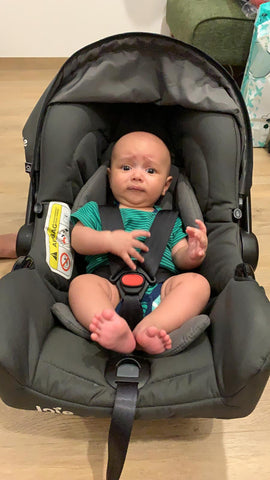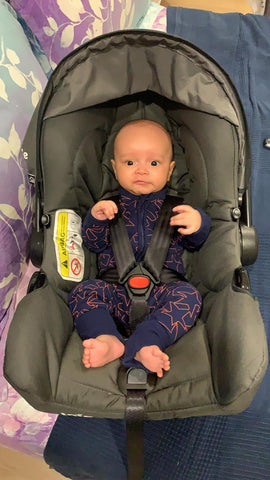
Help! My baby hates his car seat, what should I do?
Help! My baby hates his car seat, what should I do?
Driving with a crying ball of anger on board can be stressful and nerve-racking. Fret not, because we’re here to go hand in hand with you to navigate the choppy waters of parenthood! In this week’s Car Seat Chronicles, Elise advices Martha on the ways she can help her baby, James, cope with his car seat. Martha, at her wits’ end, dropped us an email as she doesn't know how she should help her baby be a happier traveller.
Martha ferries her family around with her Subaru Impreza and Volkswagen Golf. Her three-month-old, however, hates his car seat and he'd scream every time he’s in his car seat. Martha did everything she could—she adjusted his straps, made sure she changed his nappy and so on before each ride, but to no avail. She’s determined to find out the reasons why he’s constantly crying in his car seat, and is willing to change James’ car seat if it happens to be the issue.
If your little bub hates their car seats too, read further to find out Elise's recommendations. Alternatively, you may listen to the podcast below. xx
Here's the email that Martha sent us:
Hi Elise,
I’m not sure if you offer this type of advice but thought I’d ask. My 3-month-old son hates his car seat and screams every time he is in it. I’ve tried adjusting straps and make sure he has a clean nappy etc before every journey but it ends in him screaming. We’d happily buy another seat if it would resolve them problem, but we don’t know what he dislikes it so much—it seems like we should find out first. Below is an image of James in his car seat. Do you offer any fitting or advice services for this type of issue? Thank you!

As you can see, he doesn't like his Joie Gemm infant car seat. He also gets very hot in the car seat and keeps trying to sit up higher.
Here's Elise's reply and a follow-up from Martha at the end to let us know how she went!
Reasons why your child hates their car seat and what you can do
Hi Martha! Elise from Taxi Baby Co. here, thank you so much for contacting us and for filling up the checklist. Gosh, James is such a massive cutie, even if he doesn’t love his car seat as much as we’d like him to. All car seats and babies are different, and this makes it difficult to know when it’s the right time to remove the infant insert. That being said, I reckon you can try to take out the infant insert out for him and see if he’s more comfortable in his car seat sans insert.
The are a few more things you can check, and they are (let me break it down for you):
1. Does James’ car seat move after you’ve installed it?It’d be great if you can check whether James’ car seat moves side to side in the car after you’ve installed the car seat. The rationale behind this is simple: when the car seat is not installed firmly enough, children may feel a little insecure during the car ride and that can really trouble them. If you find out that your car seat does move a little after installing, feel free to let me know and I’ll share some tips on how you can achieve a firm and secure installation such that the car seat doesn’t move at all. This is sort of separate from him being upset in his car seat—the car seat should not move from side to side at all once it’s installed securely, and if it does, that can limit how well the car seat will perform in an accident.
2. Does James hate his car seat outside of the car as well? Do you find any improvement when the car is moving/stopped?In order for us to get to the root of the problem, it’d be really helpful if you could let me know when he seems to dislike his car seat the most. I want to bring your attention to an article that I’ve written for the Automobile Association of Singapore’s Highway magazine, which basically outlines a few things to check if your child always cries in the car seat. The biggest message I was trying to get across in the article is that all kids cry (unfortunately), and it’s not always because they’re uncomfortable or in pain. It’s developmentally appropriate for children to resist their car seats and even more so when they undergo developmental leaps (both physical and mental). That’s probably not the best news for you, but there’s a good chance that James might still not like his car seat even if you changed it and did everything that you could.
If you’ve tried all the things that I’ve mentioned—both in the article and here—and he still seems quite uncomfortable, perhaps you can take a look at a convertible car seat. One of the differences between an infant car seat (your car seat) and this other category of car seat is that the design of the infant car seat can be quite curved and rounded as they’re engineered for little babies. A convertible car seat on the other hand tends to have a straighter back because it suits babies and children up to the age of four-ish, and some kids really like that as they (kind of) dislike being all cozy and cooped up in their car seats. A taxi-friendly convertible car seat would be the Cosco Scenera NEXT! We’ve got that in the office so you can come and try it out*, and even if you want to borrow it for a couple of days to see if it made a difference, we can sort it out for you.
A different way to look at crying
The last thing I want to add is an extension of what I wrote in the article, and it’s really to reframe how we think of crying. When my firstborn was about six months' old or so, I discovered Janet Lansbury, who practices Resources for Infant Educarers (RIE). She wrote an article about babies crying: it sort of has nothing to do with car seats but it’s just about how we can reframe how we view crying in our own minds and not see it as the end of the world. This can be very hard to do as we’re biologically geared to have a very physical response when our kids cry, for when they could be hurt and we need to attend to them straightway. This is the way I like to see it:
I’ve got three boys, and when they are in high school/university/older and they’re sad about something—maybe they’re not doing well in class or they’re getting bullied in school or they’re having some problems with their girlfriend or boyfriend—I want them to come to me and tell me that they’re sad. I want them to feel safe, accepted and comfortable with showing me those dark, twisty, and ugly emotions. Sending them the message that “I’m not going to judge you and instead I’m going to accept these emotions” starts when kids share those emotions with us as babies. Hence, when James is crying in his car seat and if we do everything to send the message that he needs to stop crying and that you’re really uncomfortable every time he tries to share these sad emotions with you, it may reinforce the concept that you only want to hear his emotions when they are happy, shiny, shimmery emotions. In other words, if we send them the message that we’d do everything in our power to suppress these sad emotions, it may result in them not sharing those kinds of emotions as they get older.
It’s changing the way that I think about crying and it’s an active decision you’ve to make. I try to think of crying as a gift, so I try to tell myself this when they cry: “Wow, you’ve got so much trust in me and you feel so safe with me that you want to share these emotions with me and I’m incredibly honored for you to do that.”
It’s a gift because the more I learn to accept these emotions when they’re young, the better I’m going to be accepting them when they’re older. Therefore, I try and reframe my position and see that each time they cry, they’re essentially helping me to become a better parent for them when they’re going to be teenagers. You can try to communicate with them, even if they’re babies; perhaps you can tell them stuff like “Oh gosh, you sound like you’re having such a hard time, I can see that you don’t want to be in your car seat right now.” Rather than deciding that it’s your job to fix those feelings, you can try to acknowledge and accept them. This has really helped me, as all of my children have hated their car seats immensely. My firstborn, who’s five this year, cries in his car seat constantly and having that narrative that I can talk myself out of the panic helps me a lot. I hope it helps you too! I’m sorry that I’ve rambled on for so long, I hope you had a great weekend and after you’ve read the article, let me know how I can extend my help. I’ll talk to you later, bye! xx Elise
Following up, Martha sent over a picture of James in his infant car seat and here’s what she has to say:
 James in his car seat, sans infant insert.
James in his car seat, sans infant insert.
“Hi Elise! Thank you so much for your message. It really resonated with me as both a new mum and a teacher. He seems much happier now the insert has been taken out and he sat in in for ten mins without fussing or crying, which he hasn’t done for a long time! He was still trying to sit up in it, so it might be worth us trying a multi-stage seat so his back can be straighter, but I think we can try it without the insert first before committing to a new seat.
We were using it as his pushchair but at about six weeks he started crying after being in it for less than five mins. He gets extremely sweaty and hot in it, but with the insert he doesn’t seem as hot, so fingers crossed! I tried bringing it in the apartment for him to sit and play in but he would still cry and fuss. We have the ISOfix base and after checking it doesn’t seem to move at all. He will cry from the moment he’s put in the seat, but we’re going to try cartoons and toys to see if he’s just a bit bored or lonely!”
James' metrics
- Age: 3 months
- Height: 70cm
- Weight: 6.25kg
- Seated height: 42cm
- Seated shoulder height: 35cm
- Torso length: 20cm
Below is a guide to the above measurements:

*NOTE: this article was written before we closed our office due COVID-19.
If you, like Martha, need some child restraint advice from us, simply grab a consultation with our CPSTs! For more information, you may contact us at info@taxibaby.com or @taxibabyco on Facebook and Instagram. Safe travels!

